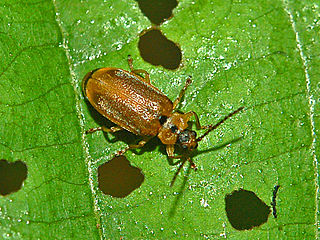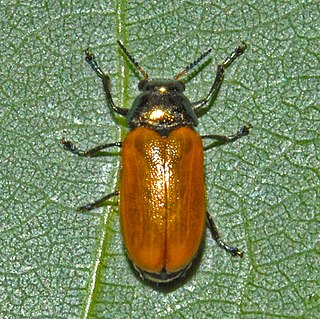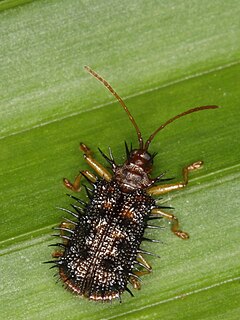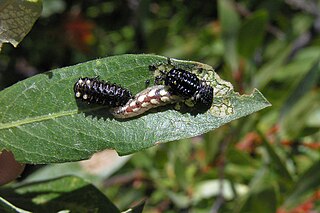
Ragweeds are flowering plants in the genus Ambrosia in the aster family, Asteraceae. They are distributed in the tropical and subtropical regions of the Americas, especially North America, where the origin and center of diversity of the genus are in the southwestern United States and northwestern Mexico. Several species have been introduced to the Old World and some have naturalized and have become invasive species. Ragweed species are expected to continue spreading across Europe in the near future in response to ongoing climate change.

Ambrosia artemisiifolia, with the common names common ragweed, annual ragweed, and low ragweed, is a species of the genus Ambrosia native to regions of the Americas.

Leaf beetles of the genus Neochlamisus are sometimes known as the warty leaf beetles. They are members of the case-bearing leaf beetle group, the Camptosomata. Measuring 3–4 millimeters in length as adults, they are cryptic, superficially resembling caterpillar frass. Seventeen, sometimes 18 species are presently accepted in this genus, all of them occurring in North America.

Zygogramma is a large genus of leaf beetles in the subfamily Chrysomelinae, which includes approximately 100 species. 13 species occur north of Mexico.

Ambrosia psilostachya is a species of ragweed known by the common names Cuman ragweed and perennial ragweed, and western ragweed.

Galeruca tanaceti is a species of leaf beetle found in the Palearctic realm, and is the type species of the genus Galeruca. It was first described by Carl Linnaeus in his 1758 10th edition of Systema Naturae.

Epiblema strenuana, the stem-galling moth or ragweed borer, is a moth of the family Tortricidae. It is endemic to North America, but was introduced to Australia from Mexico to control the weeds of the family Asteraceae in 1982. It is occasionally misspelled as Epiblema strenuanum.

Galerucella is a genus of leaf beetles in the family Chrysomelidae described by George Robert Crotch in 1873. It is widely distributed but absent in the Neotropics. Some species feed on waterlilies and are used as biocontrol of introduced, invasive waterlilies. Galerucella tenella feed on strawberry plants.

Gratiana boliviana is a species of beetle in the leaf beetle family, Chrysomelidae. Its common name is tropical soda apple leaf beetle. It is native to South America, where its distribution includes Argentina, Brazil, and Paraguay. It specializes on tropical soda apple, an invasive plant species. It has been released as an agent of biological pest control against the weedy plant in Florida and other parts of the United States.

Zygogramma disrupta is a species of beetle belonging to the family Chrysomelidae.

Zygogramma suturalis, commonly known as the ragweed leaf beetle, is a species of leaf beetle belonging to the genus Zygogramma. Native to North America, it has been introduced into Russia and China for the biological pest control of ragweed.
Ophraella slobodkini is a species of skeletonizing leaf beetle in the family Chrysomelidae. It is endemic to the Southeastern United States. Adult males measure on average 4.35 mm (0.17 in) and adult females 4.96 mm (0.20 in) in total length. It is associated with Ambrosia artemisiifolia.

Labidostomis cyanicornis is a species of short-horned leaf beetles belonging to the family Chrysomelidae, subfamily Cryptocephalinae, tribe Clytrini.
Euplatypus parallelus, previously known as Platypus parallelus, is a species of ambrosia beetle in the weevil family Curculionidae. The adults and larvae form galleries in various species of tree and logs. It is native to Central and South America but has spread globally, is present in Africa and is well established in tropical Asia.

Dicladispa armigera is a species of leaf beetle from Southeast Asia, often known by its common name: the "rice hispa". These beetles are a well known invasive pest, and are responsible for significant crop damage across many countries. The male to female ratio is between 1:1.26 and 1:1.46.

Lamprolina is an Australian genus of leaf beetles (Chrysomelidae) found in Victoria, New South Wales, and Queensland.

Parasyrphus melanderi is a flower fly that is best known as a larval predator on the leaf beetle Chrysomela aeneicollis in the Sierra Nevada range of California.

Epistictina reicheana, is a species of leaf beetle found in India, Nepal, Sri Lanka and Tasmania.
Silana farinosa, commonly known as curry-leaf tortoise beetle, is a species of leaf beetle native to Indo-China, India, Sri Lanka, Thailand and introduced to Peninsular Malaysia.

Aulacophora foveicollis, the red pumpkin beetle, is a species of beetle in the family Chrysomelidae. It is a foliar pest of members of the Cucurbitaceae, particularly the pumpkin. It is also a pest of millets in India.

















